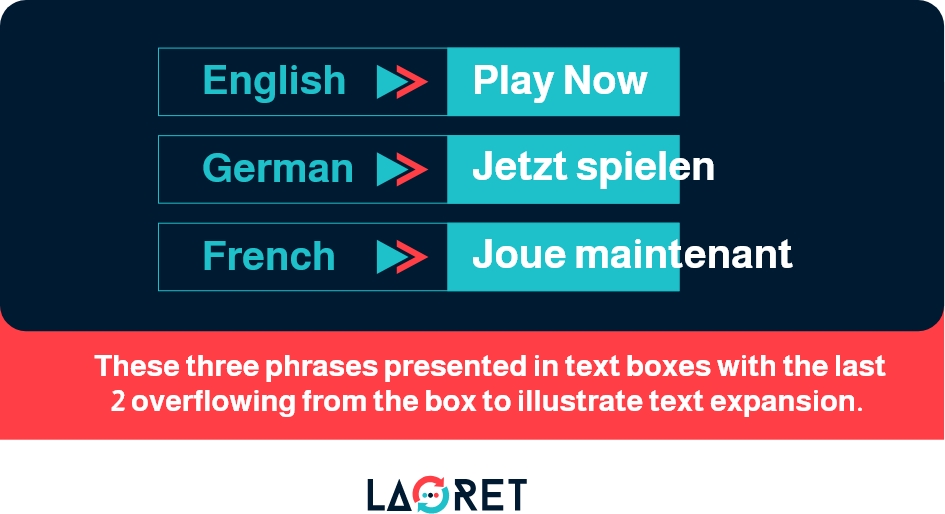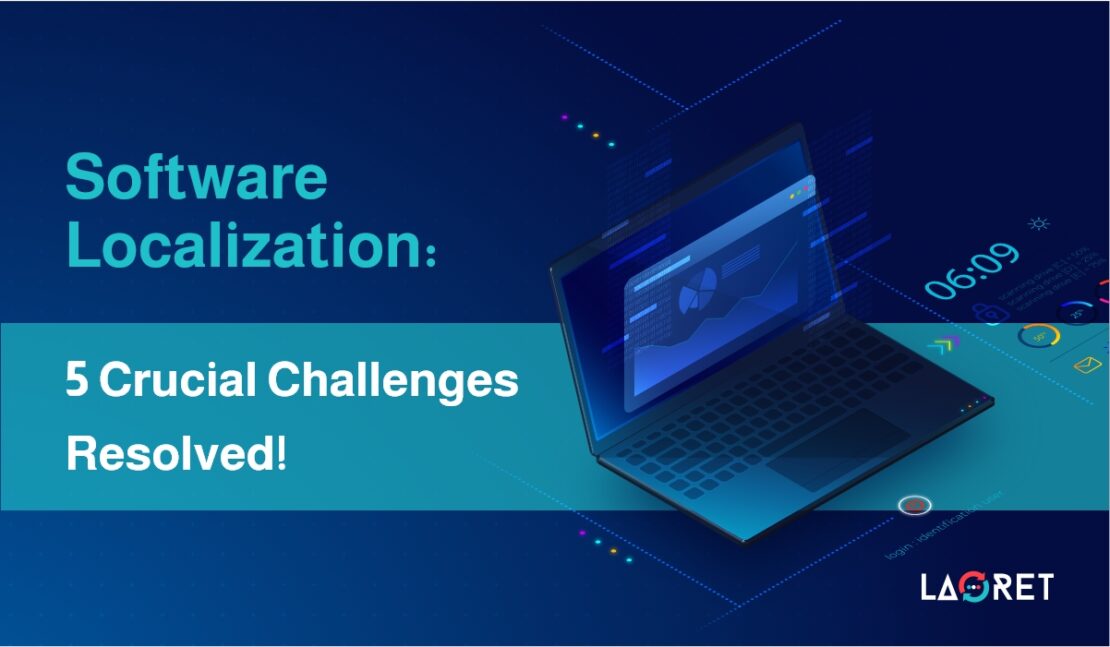Software Localization: 5 Crucial Challenges Resolved!
Do you want to introduce your product to a wider audience, but the prospect of Software Localization intimidates you? We don’t blame you! With technical, cultural, and linguistic elements to consider, software translation is highly complex. But if you are looking for a way to overcome the most arduous roadblocks, this guide to software localization best practices can help!
First Things First! What Is Software Localization?
Software Localization refers to the adaptation of software to the language and the culture of the targeted user. This cultural adaptation is performed at the linguistic level, but also in terms of technicality including User Experience (UX), design, and layout. With all these elements working together, software localization helps you create a native product that feels as if it’s only ever designed for the end users in question.
Expert software translation services follow a proven localization process that takes the regional linguistic, cultural, and technical requirements into account and addresses them in the most efficient way possible. A strategic software localization process involves 3 crucial phases:
- Internalization: the process of preparing the product for localization
- Software Localization: here, the strings are extracted, localized, and reinstated back into the code.
- Testing and QA: visual, functional, and linguistic testing is performed to ensure a high-performing, user-friendly localized software product.
We will dive more deeply into each of these steps throughout the blog and pair them with striking, real-life examples to give you valuable and actionable insights!
Key Solutions to the Biggest Software Localization Challenges
1. Localization as a Second Thought: More Costly and Time-Consuming Software Localization
Many software localization errors or costly workarounds occur before the actual localization has even started. You may not realize this, but developers already hold some power over how successful and economical the software localization process will be.
The Solution: Think Ahead and Internationalize!
Before you get started with the localization of your software product, internationalization should come first. When done right, internationalization makes localization easier, less time-consuming, and more cost-effective, since the content can more easily be adapted to different languages. Internationalization involves the preparation of your software for the localization process and removing all elements that refer to a single language application making it functional for multiple languages. Here is what that means in more detail. First of all, internationalization will simplify localization for the User Interface (UI):
- A skillful adaption to text expansion and contraction is vital. Did you know that some languages can take up to 35% more space than others? If not dealt with on a professional level, text expansion can lead to errors on both the technical and visual front.
- If you are translating into RTL Languages such as Arabic or Hebrew, you should add the markup that supports bidirectional content in your DTD. Of course, some languages, such as Asian languages, are written vertically. In this case, or in the case of any other typography with no Latin elements, you can use CSS support.
- You may be using a lot of colors and images, and these will also need to be adapted. To make this easier, do not hardcode your images and use editable formats instead.
Your strings and data format should also be developed in a manner that makes localization easier. This includes:
- No hardcoding! We may have mentioned It before, but we can’t overstate it. It will be best if you enable Unicode. Note that the most popular encoding is UTF-8.
- Similarly, your coding should be enabled to support local formats such as numbers, time, dates, and so on. For time and dates, the ISO 8601 standard is commonly applied, while numbers such as currencies are commonly standardized through the ISO 4217.
Let’s look at a striking example of internationalization done well. Developers can prevent possible time-consuming fixes related to, for example, text expansion or contraction by performing the so-called mock translation or pseudo localization. This approach estimates text expansion and contraction ratios by replacing specific text segments with random letters. Netflix, for example, heavily promotes pseudo localization as one of its pre-localization strategies.1 The company stated that as we added language support for our members residing in 190 different countries, scaling globalization at Netflix has never been more important. Along the way we’ve built out countless solutions to help us achieve globalization at scale. Have a look at an example of their pseudo localization for their mobile app!
2. Upholding Cultural and Linguistic Standards
When it comes to the linguistic side of things, localization is about more than just language translation. You have to make sure you choose the appropriate regional version of the language, and the cultural references should be effective and respectful. If you are in a situation where the language, as well as the culture, are not completely respected, you may just alienate your target audience rather than connect with them. Here is how you nail it!
The Solution: Rely on Native Experts and Linguistic QA
It is a challenge getting both the language and the cultural references completely right. Have a look at this scene from Netflix hit show Stranger Things, which is available in over 20 languages including English, Castilian Spanish, Latin American Spanish, Italian, German, Japanese, Brazilian Portuguese, and French. The official Stranger Things video explains When language isn’t a barrier, great stories have the power to travel the world.The best way to ensure these kinds of powerful, accurate, and culturally savvy translations, is to connect with experts. These experts should:
- Be native in the target language and reside there. Note how the Stranger Things team makes a distinction between Castilian Spanish, Latin American Spanish, and Brazilian Portuguese. That is because even if the same language is spoken in different countries, each country and region will have its own dialect and unique linguistic and cultural traits.
- Have translation experience and industry experience. This way, the translator can make intuitive choices.
- Follow a proven translation methodology that follows the TEP (Translation, Editing, and Proofreading) Process, so that any inaccuracies and cultural faux pas are weeded out.
To further confirm the quality of the translation, linguistic testing should be performed. Here, the spelling, grammar, cultural validity, and so on, are all double-checked for quality and compatibility with the culture the content is aimed at. fine example of top-shelf translations in the game and software localization industry is PUBG Corporation. The South Korean online game developer has a worldwide player base of hundreds of millions 2 and with games such as New State available in 17 languages.3
Part of what makes PUBG’s localization strategy effective is the considerations they have given to cultural sensitives as well as languages. For example, when their Player Unknown’s Battlegrounds was considered too violent for the Chinese market, PUGB commissioned a fully localized version of the game and renamed it Game for Peace.4 And while guns are still used in the game, the level of gore prevalent in the original game is no longer present.
3. So Many Things Can Go Wrong on the Technical Front
When not handled professionally, Software Localization can lead to a myriad of bugs and errors undermining the system. And one of these is caused by the above-mentioned text expansion. What if the developers did not apply internationalization effectively or were not very successful in their pseudo localization efforts? Have a look at this example of a Play Now button.
The Solutions: Localization Engineers, Tools, and Functional QA
If the internationalization stage hasn’t been effective in predicting text expansion issues, there are still ways to resolve them. This is where localization engineers and their sophisticated translation and localization tools have a vital part to play. Translation CAT Tools are not only there to help make the translation process run more smoothly for the linguists. Localization engineers also leverage the tool’s Quality Assurance (QA) capabilities to deliver an error-free product. For text expansion, the following techniques can be used.
- The maximum number of characters can be specified, and the tools will notify you whether the limit is met. This can be performed on the segment level.
- Alternatively, the engineer can apply a certain value to the entire file rather than just the segments and can apply a certain percentage under the QA parameter settings that cannot be exceeded.
- Some CAT Tools also have a translation preview option or a Software Translation Simulator, so translators can view their work in the correct framework and make adjustments accordingly.
But there was another concern we raised. How can localization engineers ensure that the code will not be compromised during the translation process? Enter regular expressions! Regular Expressions are implemented into the CAT Tool by the localization engineer. It identifies the content that should not be translated, or the code, and locks it so it cannot be edited. This non-translatable content will be displayed as a tag. Have a look at this screenshot from one of our projects. Locking down the code (purple) means that linguists cannot accidentally edit these strings, and a wide range of possible errors are prevented in the process.
4. Visually, Software Localization is No Piece of Cake Either
Beyond the more technical issue of text expansion which can undermine the UX and make content appear truncated or too long, other visual elements can interfere with perfectly executed software localization. RTL languages are rising in prominence and languages such as Arabic are becoming more important in the localization world. But this has also brought a visual challenge to it. As these languages are directed from right to left rather than left to right, the design will need to be adjusted to accommodate the new language while still maintaining the original power of the design. Additionally, certain images, colors, and symbols might have to be replaced depending on the target locale. For example, if you intend to use specific gestures in your imagery, make sure you know which ones are appropriate to use. While in the United States, for example, joining the index finger and thumb in a circle signifies okay, this is actually considered a lewd gesture in Brazilian culture. In fact, the New York Times described the gesture as having “insulting and scatological connotations.” In the 1950s.5 Richard Nixon famously raised more than an eyebrow or two when he made the gesture when arriving in Brazil.6 Of course, we are not living in the 1950s anymore and globalization has led to different cultures understanding the meaning behind certain symbols, but the cultural connection will still be there.
The Solutions: Native Experts, Desktop Publishing, and Visual QA
When it comes to cultural relevance of the imagery you are using, here too native expertise will be vital. Beyond the linguists who will give you stellar multilingual content, local experts will also help you by providing you with insights into what your target locale appreciates, what their customs are, and what types of visualization will be sensitive. For example, developers in China had created a healthcare app called Chunyu Yisheng which was intended for inhabitants of the more rural areas to easily interact with physicians. The application makes excessive use of green since Chinese culture associates this with harmony and health.7So, what about those RTL languages? How can they be prevented from causing visual issues? This is where the Desktop Publishing Experts come in. Desktop Publishing Services include anything to do with formatting design optimization for different locales. They will:
- Make sure that languages with different directions fit optimally within the design.
- Confirm that all details are in order, including the fonts! Because indeed, not every font fits every language or even preference.
Finally, every software localization project will include visual QA. At this stage, all the elements that influence the UX will be tested and confirmed. This includes graphics, numbers, formatting, and so on.
5. Software Localization Is Resource Intensive
Linguists, localization engineers, designers, DTP experts, a special localization platform, QA tests… It sounds like a lot. But as you have seen in our previous points, each one of these elements is vital to ensure the localization process is fully successful. Software localization is highly collaborative; all have a part to play to deliver the best possible outcome.
The Solution: Centralize Your Localization Efforts and Connect with an LSP
If you are aiming for a full-scale software localization where every detail of the process is taken care of, it will be beneficial for you to connect with a Languages Service Provider (LSP). They will have an extensive network of professionals right at their fingertips and also leverage the most up-to-date translation tools that will make the more technical challenges a breeze.
Conclusion:
Software Localization services involve a complex process of linguistic, cultural, and technical elements. For it to be successful, internationalization, localization, and Quality Assurance should be performed on a professional level. This means that in order to deliver the best possible product that connects with your end-user, you will need to rely on the enterprise of native language experts. At Laoret, we only work with native linguists, tech-savvy localization engineers, and optimized translation and localization resources. Contact Us! We are available 24/7.
References
- pseudo-localization-netflix
- statista.com/statistics/755111/pubg-number-players/
- pubg-new-state-all-set-to-be-launched-on-nov-11-at-930-am-in-17-languages
- china-pubg-replacement-game-for-peace-violence
- what-s-a-ok-in-the-usa-is-lewd-and-worthless-beyond
- chicagotribune.com/news/ct-xpm-1992-01-26-9201080471-story.html
- china-app-doctors-patients-chunyu-yisheng/








